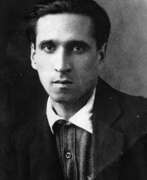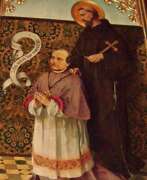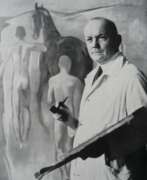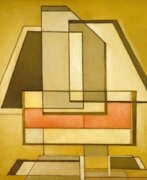Glass painters 20th century


Edmond Bille was a Swiss artist. Bille engaged in intense and varied activity as painter, engraver, stained glass artist, journalist, writer, and politician. He is the creator of the stained glass windows around the altar of the Cathedral of Lausanne, capital of the Swiss canton of Vaud.
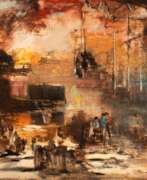

Paul Bücher was a German painter and stained glass artist.
He studied at the Düsseldorf School of Applied Art, then at the Düsseldorf Academy of Art, and was a member of the Malkasten Artists' Association.
Paul Bücher, as a painter of glass, created stained glass with figurative images, wall paintings and panels. Later he became involved in landscape painting, particularly of the Lower Rhine.
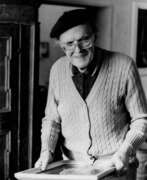

Albert Burkart was a German painter. His artistic work was based on the style of the New Objectivity around 1925. Burkart began working as a freelance painter in Munich in 1925. In the following years he created pictures and graphic sheets for the annual exhibitions in Munich and the galleries Heinemann and Tannhäuser. He also worked for Munich publishers, including the magazine Die Jugend. The Bavarian state and the city of Munich bought several of his works. He painted and drew industrial landscapes, workers, suburbs, old people and children in the big city before starting to create religious paintings, frescoes and stained glass windows and work for churches. One of his first religious works was the monumental painting of the choir of the Church of St. Joseph in Memmingen. His paintings combine sacral depictions with rich narratives and an architectural conception of space. Albert Burkart was a member of the artists' association "7 Munich painters". The association existed between 1930 and 1937.


Hans Christiansen was a German painter, representative of classical modernism, decorator and illustrator.
Christiansen trained as a decorative painter in Flensburg and then at the School of Applied Arts in Munich, later studying at the Académie Julian in Paris. After a study trip to Italy in 1889, he moved to Hamburg, where he taught at the Technical University.
At the same time, Christiansen worked as a freelance decorative artist and was active in the Volkskunst-Verein, and was one of the founders and first residents of the Darmstadt artists' colony of the late 19th and early 20th century. Together with Josef Olbrich and Peter Behrens, he designed furniture, ceramics, tapestries, stained glass and graphic posters. He also designed his own house in the colony, which he called "Villa Rose," which was destroyed during World War II.
During this time, the versatile artist also wrote regularly for the magazine Jugend, creating many illustrations and covers. From 1911 he lectured at the Wiesbaden School of Arts and Crafts and was a member of the Wiesbaden Free Artists Association.
In 1933, Christiansen's work was banned by the Nazi Party of Germany because of his Jewish wife, and he was almost forgotten until his death in 1945.


Eleanor Fortescue-Brickdale was a British Pre-Raphaelite painter, illustrator and stained glass artist.
At the age of 17, she enrolled at Crystal Palace School of Art and was later admitted to the Royal Academy of London and she initially worked with illustration. In 1897, Eleanor won a prize for her painting "Spring", which allowed her to begin work on her first large-scale oil painting, "The Pale Color of True Love". The painting was exhibited at the Royal Academy in 1899.
In 1902 Eleanor Fortescue-Brickdale was elected the first female member of the Institute of Oil Painters. She illustrated many books, including Tennyson's Royal Idylls in 1911. She taught at the Byam Shaw School of Art in Kensington. During the First World War, the artist designed posters for government departments and later several commemorative stained glass windows and a memorial in York Cathedral. In 1919 she became a member of the Royal Society of Watercolor Painters.


Sepp Frank was a German painter, glass painter, etcher and graphic artist.
He studied at the Munich Academy of Fine Arts. Frank went on numerous study trips early on to further his education. He soon turned to graphics and is still known today for his numerous bookplates. He lived for several years in Neustadt an der Aisch, where there is a large painting of Prince Regent Luitpold in the town hall.
In addition to portrait painting, another field of activity was stained glass.


Ernst Günter Hansing was a German artist of the twentieth and twenty-first centuries. He is known as a painter and graphic artist who worked in a variety of genres and styles.
Hansing began his artistic career in Paris, he studied under Fernand Léger and was influenced by his style for some time. He later became known for his portraits of famous personalities including politicians, religious figures, artists and musicians. In addition to portraiture, Hansing created abstract paintings and also worked on church stained glass windows.




Maurice Max Ingrand, better known as Max Ingrand was a French artist and decorator, known for his work in studio glass and his stained glass windows.
Ingrand created numerous church stained glass windows during the late 1940s to 1960s. In the aftermath of World War II, he was tasked with replacing 47 of the stained glass windows destroyed at Notre-Dame de Paris.
Max Ingrand was noted for his modern designs.


Kim En Joong is a South Korean Dominican priest, painter, stained glass artist and renowned artist.
Representing abstract landscape painting, his non-figurative canvases, nourished by new technical notions of space and perspective, impose a change of scenery, the starting point of a quest for divine mystery.
In his pictorial works, what is striking is the impression of "liquidity" or "fluidity" of the pigments used. Thanks to delicate, pure and clear colours, Kim En Joong creates a fairytale-like spectacle by playing on the liveliness of the tones and the subtle contrasts.


Hans Kaiser was a German painter and stained glass artist.
Kaiser is best known for his large-scale work in Washington, USA, where he created stained glass windows for the National Cathedral. In addition, he performed many commissions in Germany to create windows, stained glass, and glass mosaics for many churches and public buildings.
Hans Kaiser also painted a series of abstract landscapes of the Mediterranean.


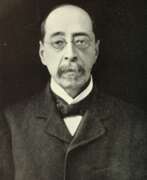

John La Farge was an American artist whose career spanned illustration, murals, interior design, painting, and popular books on his Asian travels and other art-related topics.
La Farge is best known for his production of stained glass, mainly for churches on the American east coast, beginning with a large commission for Henry Hobson Richardson's Trinity Church in Boston in 1878, and continuing for thirty years. La Farge designed stained glass as an artist, as a specialist in color, and as a technical innovator, holding a patent granted in 1880 for superimposing panes of glass. That patent would be key in his dispute with contemporary and rival Louis Comfort Tiffany.


Jacques Le Chevallier was a French glassmaker, decorative artist, illustrator, and engraver. He was mobilized during World War I; after the war he became a master artisan in the studio of Louis Barillet, with whom he remained until 1945. His collaborators there included Théodore-Gérard Hanssen.


Alfred Manessier was a French painter and graphic artist, a representative of the New Paris School and the Salon de May.
He was educated at the Ecole Nationale Supérieure des Beaux-Arts in Paris and was fascinated by Cubism, Surrealism, Fauvism, like many artists of that generation. But at the same time he studied with the old masters and with the coryphaei of Impressionism. In the middle of his life, Manassier reconsidered his views and turned to religious subjects and landscapes with sea views. He became involved in stained glass and tapestry art.


Burkhard Mangold was a Swiss artist, poster designer, illustrator, painter, graphic artist, and stained glass artist. He created murals and was a pioneer of Swiss poster art, developing a unique style of his posters. He has been called the "grandfather of the Basel School.
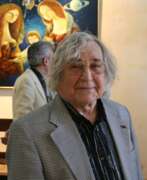

René Margotton was a French cubist painter of the Paris School. He was called the "artist of light" for his stained glass art.
He created many stained glass windows in France for the Church of St. Martin in Vallauris, the Basilica of St. Martin in Tours, and the Basilica of St. Pius X in Lourdes, which houses 20 jewels.
René Margotton is the father of the French painter and sculptor Bernard Romain.


Louis René Moilliet is a Swiss painter, stained glass designer, and watercolorist. From his trips to Tunisia he brought back many urban sketches, portraits, landscapes painted in watercolor. In painting, Mouaillet adhered to expressionist and orphic styles.




Robert Pansart was a French glassmaker and decorator, specialising in engraved, oxidised and eglomerated glass techniques.
Although he is best known for his mirrors decorated with figures and arabesques, Pansart also made a number of pieces of furniture with rather fantastic baroque shapes, reminiscent of the world of fairy tales.


Ronald Paris, a renowned German painter and graphic artist, left an indelible mark on the art world. His journey in art began with studies in glass art and stained glass, transitioning to mural painting, where he honed his craft under notable mentors at the Visual Arts Academy in Weissensee, Berlin.
Ronald Paris's career was marked by his unique portrayal of subjects, often challenging the prevailing narratives of his time. Notably, his 1961 triptych "Village Games in Wartenberg" faced criticism for its honest depiction of workers, diverging from the idealized views enforced by East Germany's leadership. His dedication to realism and expressive content continued throughout his career, culminating in notable works such as the mural "Triumph des Todes" and the altar piece for the Trinitatis-Kirche in Sondershausen.
Throughout his life, Ronald Paris's works were celebrated and exhibited across Germany, earning him prestigious awards like the Käthe-Kollwitz-Medaille and the Nationalpreis der DDR. His legacy endures through his contributions to various exhibitions and his role as a professor at the Burg Giebichenstein Arts Academy in Halle.
For art collectors and enthusiasts, Ronald Paris's oeuvre offers a deep dive into the essence of German postwar and contemporary art, embodying a profound realism that captures the spirit of his times.
If you're passionate about exploring the rich tapestry of German art, Ronald Paris's work offers a captivating blend of historical insight and artistic innovation. Sign up for updates to stay informed about sales, auctions, and exhibitions featuring Ronald Paris's art, and delve into the world of a painter who not only witnessed but also painted history with a bold and realistic brushstroke.


Victor Noble Rainbird was a British painter, stained glass artist and illustrator.
Victor Noble Rainbird studied at King's College, Newcastle-upon-Tyne, where he distinguished himself and won several prizes. His paintings were included in a government exhibition which travelled to Australia, New Zealand and Canada.
Reinberd's work often depicts views and the waterfront and sea around North Shields and other Tyne harbours. He made several trips to France, Belgium and the Netherlands, and the bulk of his work focuses on his travel experiences. Rarer subjects include stained glass windows, portraits and still lifes (flowers).


Markey Robinson, born James Markus Robinson, was an Irish self-taught artist and sculptor who worked in the Primitivist style.
From the age of 19, Robinson worked on merchant ships as a steward, traveling throughout Canada, the United States and South America. With the outbreak of World War II, he decided to take up painting, studied for a while at the Belfast College of Art, exhibited at the Ulster Academy of Art from 1941-1942 and even had success.
Robinson was known as a rather edgy and eccentric man who led a bohemian lifestyle. The subjects of his generally primitive and expressionist works included nautical themes, clowns, and landscapes of France and Ireland. By the mid-1950s, Robinson was on the lips of critics and the public, exhibited extensively, and was hailed as a genius by the Belfast newspapers. For the rest of his life his work was controversial: some considered him a gifted creator, others a populist who had outlived his early creative originality in the pursuit of profit.


Ugo Rondinone is a Swiss-born artist widely recognized for his mastery of several different media — most prominently sculpture, drawing and painting, but also photography, architecture, video and sound installation — in the largely figurative works he has made for exhibitions in galleries, museums and outdoor public spaces around the world. He has never limited himself to a particular material, no more than he has to a single discipline. Lead, wood, wax, bronze, stained glass, ink, paint, soil and stone are all tools in a creative arsenal that the artist has employed to extend the Romantic tradition in works that are as sensitive to the passage of time as to the nuances of body language and the spoken word.


Georges Rouault was a French painter, printmaker and ceramicist whose profound works combined art and spirituality, making him a key figure in the contemporary art world. Born into a modest family in Paris during the turbulent times of the Paris Commune, Rouault's early exposure to art came through his grandfather's collection of lithographs by Honoré Daumier. His initial apprenticeship in a glazier's workshop had a profound influence on his artistic style, especially his work with stained glass, which later became a hallmark of his painting technique.
Rouault's career took a significant turn under the tutelage of Symbolist painter Gustave Moreau, who introduced him to avant-garde circles, leading Rouault into the Fauvist movement alongside Henri Matisse. However, Rouault's unique approach was characterized by a more instinctive and spontaneous style that was deeply influenced by Vincent van Gogh and which eventually led him to Expressionism. His works from this period, dealing with subjects such as courts, clowns, and prostitutes, served as a form of moral and social criticism, motivated by his deep Christian faith and concern for human nature. This period marked a significant evolution in Rouault's style; his paintings reflect a mixture of religious iconography and human suffering, demonstrating his mastery of conveying deeply emotional and spiritual stories.
One of Rouault's most notable contributions to art was his involvement in the scenography for Sergei Diaghilev's ballet The Prodigal Son and his famous series of paintings and prints such as Miserere. His later works are renowned for their explosive use of color and texture, highlighting his mastery of expressing the spiritual harmony and beauty of nature. The end of Rouault's career was marked by a gesture of humility and dedication to his craft: he destroyed a significant number of his unfinished works, feeling that he could not complete them to his satisfaction.
Rouault's legacy has been preserved through his impressive works in renowned museums and galleries around the world. His art continues to inspire and resonate with collectors, experts and lovers of art and antiques, serving as a testament to his enduring influence on the art world.
For those deeply interested in exploring the life and work of Georges Rouault, it is important to stay abreast of new discoveries, sales, and auction events related to his art. We encourage you to subscribe to updates so that you don't miss out on the opportunity to engage with the legacy of this remarkable artist. This subscription will be your gateway to the world of Georges Rouault, offering exclusive insights into his contribution to contemporary art.


Henry Ryland was a British painter, book illustrator, decorator and designer. He exhibited at the Grosvenor Gallery, and from 1890 at the Royal Academy. He also was a regular exhibiter at the New Gallery and the Royal Institute of Painters in Water Colours (formerly the New Society of Painters in Water Colours). He became a full member of the latter institution. Although he did paint in oils, he specialized in highly finished watercolour paintings containing images of young women in classical draperies on marble terraces. His watercolours were widely reproduced as prints. Ryland also designed stained glass and his woodcuts were used in a number of magazines, including the English Illustrated Magazine in the 1880s and 1890s.


Hans Schreiner was a German painter and stained glass artist.
Hans Schreiner, a graduate of the Stuttgart Academy, in the mid-1950s became a member of the Group of 11, which also included Atila Biro, Günter K. Kirchberger, Friedrich Sieber and Georg Karl Pfahler. The artist called himself an abstract landscape painter, he used, among other things, the Informel style to create symbolic imagery. In addition to painting,
Schreiner also designed stained glass windows and structures for churches. He was a member of the Association of German Artists and actively participated in exhibitions.


Franz Wenzel Schwarz was a German-Bohemian painter of the second half of the nineteenth and early twentieth centuries. He is known as a portrait painter, master of historical genre and glass artist.
Schwarz created many portraits of churchmen, scholars, high officials, major businessmen, as well as children and women. He also created many religious paintings and stained glass windows for churches. He was a member of the Society of Artists of Vienna and other artistic associations. In the later part of his career, Schwarz concentrated on creating genre and portrait paintings, selling them to various countries, including America and Russia. Between 1912 and 1918, he copied paintings from the Old Masters Picture Gallery in Dresden.


Vladimir Ivanovich Stelmashonok (Russian: Владимир Иванович Стельмашонок) was a Belarusian and Soviet artist of the second half of the twentieth and early twenty-first centuries. He is known as a painter, graphic artist and teacher.
Vladimir Stelmashonok worked in different genres and techniques. In easel painting he created mainly portraits - mainly of figures of history and culture of Belarus. In monumental and decorative art, the creative heritage of the artist includes a number of monumental works in Minsk, Ukraine and East Germany, including stained glass windows and mosaics for metro stations.


Louis Comfort Tiffany, an American artist, is revered for his significant contributions to the Art Nouveau movement and for revolutionizing the art of glassmaking. As the son of the founder of Tiffany & Co., Charles Lewis Tiffany, Louis was predisposed to a life surrounded by opulence and artistry. His early years were marked by training under prominent painters and a comprehensive education in the arts, which included a stint at the National Academy of Design in New York.
Louis Comfort Tiffany's foray into the world of stained glass was not merely an extension of his artistic pursuits but a manifestation of his relentless quest for innovation and beauty. His early work with stained glass utilized materials with mineral impurities, lending his pieces a distinct quality that set them apart from the conventional. His dedication led to the opening of his own glass factory in Corona, New York, where he developed and patented the "copper foil" technique. This method, contrasting sharply with the traditional lead came technique, allowed for greater detail and complexity in his stained glass creations.
Louis Comfort Tiffany's contributions weren't limited to stained glass; his ventures into lighting and lamps in 1898 brought about iconic designs that combined functionality with aesthetic beauty. His lamp designs, characterized by their unique selection of glass and organic forms, are celebrated for their intricate detail and artistry. Tiffany's work also extended to mosaics, enamelwork, pottery, and jewelry, showcasing his versatility and innovative spirit across multiple mediums.
Perhaps one of Louis Comfort Tiffany's most majestic installations is the Mosaic Curtain at the Palacio de Bellas Artes in Mexico City. Commissioned for its exceptional craftsmanship, the curtain is a testament to Tiffany's mastery over glass, reflecting his ability to blend artistic vision with technical prowess. This monumental piece, composed of nearly one million pieces of favrile glass, illustrates a vibrant landscape that comes to life under changing light conditions, embodying the essence of Art Nouveau's fascination with nature and innovation.
Louis Comfort Tiffany's legacy is a rich tapestry of artistic achievement that has left an indelible mark on the worlds of art and design. His work, characterized by a deep appreciation for the natural world and a pioneering approach to materials and techniques, continues to inspire and captivate collectors and art enthusiasts around the globe.
For those interested in exploring the depth and beauty of Tiffany's creations, staying updated on new discoveries, exhibitions, and auction events related to his work is essential. Signing up for updates ensures that enthusiasts and collectors are always informed about opportunities to engage with the magnificent legacy of Louis Comfort Tiffany.


Franz Xaver Zettler was a German stained glass artist. He started his own stained glass design company in 1870. He designed some of the stained glass in the Deutsche Evangelische Christuskirche in Knightsbridge, London in 1904-1905. He designed a window depicting The Crucifixion that today stands in Badin Hall.


